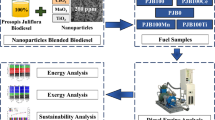Abstract
The homogeneous charge compression ignition (HCCI) is an alternative combustion concept for reciprocating engines. This study investigates an HCCI engine fuelled with Diethyl ether (DEE) ignition assisted wet ethanol (ethanol with 20% water content). The direct use of wet ethanol could reduce the associated energy required for distillation and dehydration of ethanol. The HCCI engine offers significant benefits in terms of its high efficiency and ultra low emissions. The experiment is conducted with various DEE flow rates and at different air-fuel ratios, for which stable HCCI combustion is achieved. Incylinder pressure, heat release analysis and exhaust emissions were observed. In this study, the effect of DEE on combustion parameters, thermal efficiency and emissions is analysed and discussed in detail. The experimental results indicate that the DEE flow rates have a significant effect on the maximum in-cylinder pressure and its position, thermal efficiency, maximum rate of pressure rise and the heat release rate. Results show that for all stable operating points, brake thermal efficiency is higher than reference mode at lower loads and almost same at higher loads. The emission parameters such as NO, HC and CO are lower than the dual fuel mode which is considered as a reference model for this experiment.
Similar content being viewed by others
References
Christensen, M. and Johansson, B. (1999). Homogenous charge compression ignition with water injection. SAE Paper No. 1999-01-0182.
Christensen, M., Johansson, B. and Einewall, P. (1997). Homogeneous charge compression ignition (HCCI) using isooctane, ethanol and natural gas-a comparison with spark-ignition operation. SAE Paper No. 972874.
Christensen, M., Johansson, B., Amneus, P. and Mauss, F. (1998). Supercharged homogeneous charge compression ignition. SAE Paper No. 980787.
De Caro, P. S., Mouloungui, Z. and Vaitilingom, G. (2001). Interest of combining an additive with diesel-ethanol blends for use in diesel engines. Fuel 80, 4, 565–574.
Flowers, D. L., Aceves, S. M. and Frias, J. M. (2007). Improving ethanol life cycle energy efficiency by direct utilization of wet ethanol in HCCI engines. SAE Paper No. 2007-01-1867.
Ganesh, D. and Nagarajan, G. (2010). Homogeneous charge compression ignition (HCCI) combustion of diesel fuel with external mixture formation. Energy, 35, 148–157.
Haraldsson Goran, T., Johansson, B. and Hyvonen, J. (2002). HCCI combustion phasing in a multi cylinder engine using variable compression ratio. SAE Paper No. 2002-01-2858.
Heywood, J. B. (1988). Internal Combustion Engine Fundamentals. McGraw-Hill. New York.
Iida, M., Hayashi, M., Foster, D. E. and Martin, J. K. (2003). Characteristics of homogeneous charge compression ignition (HCCI) engine operation for variations in compression ratio, speed, and intake temperature while using n-butane as a fuel. J. Eng. Gas Turbines Power, 125, 472–478.
Iwashiro, Y., Tsurushim, T., Nishijima, Y., Asaumi, Y. and Aoyagi, Y. (2002). Fuel consumption improvement and operation range expansion in HCCI by direct water injection. SAE Paper No. 2002-01-0105.
Lu, X.-C., Yang, J.-G., Zhang, W.-G. and Huang, Z. (2004). Effect of cetane number improver on heat release rate and emissions of high speed diesel engine fueled with ethanol-diesel blend fuel. Fuel, 80, 14–15.
Mack, H., Aceves, S. M. and Dibble, R. W. (2009). Demonstrating direct use of wet ethanol in a homogeneous charge compression ignition (HCCI) engine. Energy, 34, 782–787.
Madison (2004). Revelation Operator Reference Manual (USA). Hi-Techniques Inc. 95–96.
Megaritis, A., Yap, D. and Wyszynski, M. L. (2007). Effect of water blending on bio-ethanol HCCI combustion with forced induction and residual gas trapping. Energy, 32, 2396–2400.
Rakesh, K. M. and Avinash, K. A. (2011). Experimental study of combustion and emission characteristics of ethanol fuelled port injected homogeneous charge compression ignition (HCCI) combustion engine. Applied Energy 88, 4, 1169–1180.
Sudheesh, K. and Mallikarjuna, J. M. (2010). Diethyl ether as an ignition improver for biogas homogeneous charge compression ignition (HCCI) operation - An experimental investigation. Energy, 35, 3614–3622.
Author information
Authors and Affiliations
Corresponding author
Rights and permissions
About this article
Cite this article
Vinayagam, N., Nagarajan, G. Experimental study of performance and emission characteristics of DEE-assisted minimally processed ethanol fuelled HCCI engine. Int.J Automot. Technol. 15, 517–523 (2014). https://doi.org/10.1007/s12239-014-0054-2
Received:
Revised:
Accepted:
Published:
Issue Date:
DOI: https://doi.org/10.1007/s12239-014-0054-2




